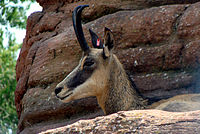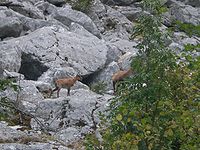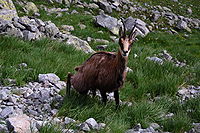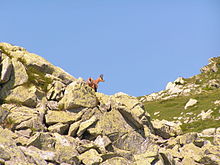- Chamois
-
Chamois 
Conservation status Scientific classification Kingdom: Animalia Class: Mammalia Order: Artiodactyla Family: Bovidae Subfamily: Caprinae Genus: Rupicapra Species: R. rupicapra Binomial name Rupicapra rupicapra
(Linnaeus, 1758)The chamois, Rupicapra rupicapra, is a goat-antelope species native to mountains in Europe, including the Carpathian Mountains of Romania, the European Alps, the Tatra Mountains, the Balkans, parts of Turkey, and the Caucasus. The chamois has also been introduced to the South Island of New Zealand. Some subspecies of chamois are strictly protected in the EU under the European Habitats Directive.[2]
Contents
Names
The English name is from the French chamois. This is derived from Latin camox, borrowed from Gaulish, itself perhaps a borrowing from Iberian or Aquitanian, akin to modern Basque ahuntz, "goat".
The usual pronunciation for the animal in British English is /ˈʃæmwɑː/, or in American English /ʃæmˈwɑː/, approximating the French pronunciation. However when referring to chamois leather, and in New Zealand often for the animal itself, it is /ˈʃæmi/, and sometimes spelt "shammy" or "chamy". The plural of "chamois" is spelled the same as the singular, and it may be pronounced with the final "s" sounded: /ˈʃæmwɑːz/, /ʃæmˈwɑːz/, /ˈʃæmiz/. However, as with many other quarry species, the plural for the animal is often pronounced the same as the singular.
The Dutch name for the chamois is gems, and the male is called a gemsbok. In Afrikaans, the name "gemsbok" came to refer to a species of Subsaharan antelope of the genus Oryx, and this meaning of "gemsbok" has been adopted into English.
Taxonomy
There are two species of chamois in the genus Rupicapra: R. rupicapra and R. pyrenaica, which occurs in the Pyrenees and the Appennines. The chamois (along with sheep and goats) are in the goat-antelope subfamily (Caprinae) of the family Bovidae.
The chamois (Rupicapra rupicapra) is categorized into several subspecies:
- R. r. rupicapra (Alpine chamois): Austria, France, Germany, Italy, Switzerland, Slovenia,[3] Slovakia (Veľká Fatra, Slovak Paradise)
- R. r. tatrica (Tatra chamois): Slovakia (Tatras and Low Tatras) and Poland (Tatras)
- R. r. balcanica (Balkan chamois): Albania, Bosnia and Herzegovina, Bulgaria, Croatia, northern Greece (The Pindus Mountains),[4] Republic of Macedonia, Serbia, Montenegro, and Slovenia (isolated populations)[3]
- R. r. carpatica (Carpathian chamois): Romania
- R. r. cartusiana (Chartreuse chamois): France
- R. r. asiatica (Anatolian chamois or Turkish chamois): Turkey
- R. r. caucasica (Caucasian chamois): Azerbaijan, Georgia, Russian Federation
Biology and behaviour
Chamois live at moderately high altitudes and are adapted to living in steep, rugged, rocky terrain. A fully grown chamois reaches a height of about 75 centimetres (30 in) and weighs between 20 kilograms (44 lb) and 30 kilograms (66 lb). Both males and females have short, straightish horns which are hooked backwards near the tip. In summer, the fur has a rich brown colour which turns to a light grey in winter. Distinct characteristics are a white face with pronounced black stripes below the eyes, a white rump and a black stripe along the back. Chamois can reach an age of 20 years.
Female chamois and their young live in herds; adult males tend to live solitarily for most of the year. During the rut (late November/early December in Europe, May in New Zealand), males engage in fierce battles for the attention of unmated females. An impregnated female undergoes a gestation period of 20 weeks, after which a single kid is born. The kid is fully grown by 1 year of age.
Distribution and habitat
New Zealand
Alpine chamois arrived in New Zealand in 1907 as a gift from the Austrian Emperor, Franz Joseph I. The first surviving releases were made in the Aoraki/Mount Cook region and these animals gradually spread over much of the South Island.[5][6]
In New Zealand, hunting of chamois is unrestricted and even encouraged by the Department of Conservation to limit the animal's impact on New Zealand's native alpine flora.[6][7]
New Zealand chamois tend to weigh about 20% less than European individuals of the same age, suggesting that food supplies may be limited.[8]
Hunting and wildlife management
As their meat is considered tasty, chamois are popular game animals. Chamois have two traits that are exploited by hunters. The first is that they are most active in the morning and evening when they feed. The second trait is that chamois tend to look for danger from below. This means that a hunter stalking chamois from above is less likely to be observed and more likely to be successful.[9]
The tuft of hair from the back of the neck, the gamsbart (chamois "beard"), is traditionally worn as a decoration on hats throughout the alpine countries.
Chamois leather
Chamois leather, traditionally made from the hide of the chamois, is very smooth and absorbent and is favoured in cleaning and polishing because it produces no streaking. Modern chamois leather may be made from chamois hide, but hides of deer or domestic goats or sheep are commonly used.
See also
References
- ^ Aulagnier, S., Giannatos, G. & Herrero, J. (2008). Rupicapra rupicapra. In: IUCN 2008. IUCN Red List of Threatened Species. Downloaded on 5 April 2009. Database entry includes a brief justification of why this species is of least concern.
- ^ Council Directive 92/43/EEC of 21 May 1992 on the conservation of natural habitats and of wild fauna and flora at EUR-Lex
- ^ a b Mineral Supply and Fertility of Chamois
- ^ Current status of the Balkan chamois (Rupicapra rupicapra balcanica) in Greece : Implications for conservation at Royal Belgian Institute of Natural Sciences
- ^ A Note on the Chamois in New Zealand at New Zealand Ecological Society
- ^ a b Recreational hunting in Nelson/Marlborough - Chamois at the Department of Conservation
- ^ Heritage Preservation (p. 40 and 45) at the Department of Conservation
- ^ Chamois in New Zealand at NZ Hunting Info
- ^ Chamois Hunting NZ 2005 - A Guide for the Fit young Novice at NZ Hunting Info
External links
- ITIS (Integrated Taxonomic Information System) report for the species Chamois
- New Zealand Chamois and their distribution in New Zealand
 Texts on Wikisource:
Texts on Wikisource:
- Chisholm, Hugh, ed (1911). "Chamois". Encyclopædia Britannica (11th ed.). Cambridge University Press.
- "Chamois". Encyclopedia Americana. 1920.
Categories:- IUCN Red List least concern species
- Caprids
- Mammals of Europe
- Mammals of Southwest Asia
- Mammals of Russia
- Fauna of Central Asia
- Mammals of Italy
- Fauna of Italy
- Animals described in 1758
Wikimedia Foundation. 2010.






